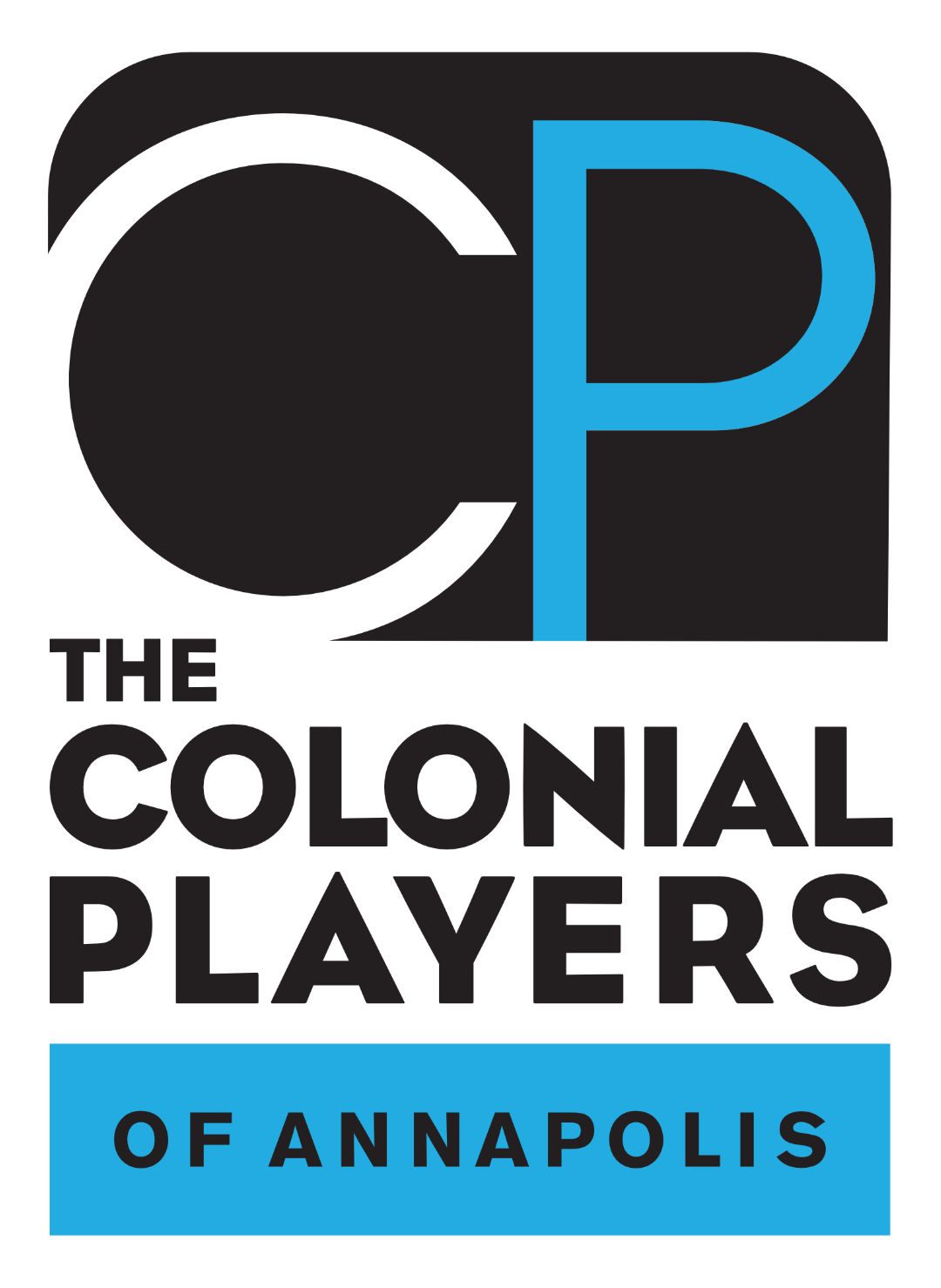SATURDAY, MARCH 14, 2015
Offbook: 50 Shades of Theatre
By Sarah Wade
Hello readers! That’s right. They turned over the keys to the blog (just go with it) to me. No, no, don’t go! Stay! This will be fun! For those of you who don’t know me, you may have seen me in The Liar, A Christmas Carol (seven years!), These Shining Lives, Annie, Communicating Doors, and Taking Steps, amongst others. I also had my first foray into sound design for Watch on the Rhine, which is currently running. I’ve been very lucky to grow up at Colonial Players, having early memories of playing with my Barbies in the seats while my dad directed something or other. I know these walls well (did you know that 13-year-old Sarah is why the roof is kept locked now? True story. I’ll tell you about it later). Enough about me now. Onwards and upwards!
Upon being asked to do the blog, I wanted to cover territory I was familiar with, and it seems only appropriate in my first post to give a nod to my predecessor, Jeff, who I had the honor of slapping four times a night in The Liar. Hard. He took it like a champ. In These Shining Lives, Ben Carr was in the position of being my first actual stage kiss. And boy, was I nervous. More on that later. But what ties these two together? As The Liar director Steve Tobin puts it, “Both can be awkward, embarrassing, and painful – for the audience, as well as for the actors. Both are improved by trust, patience, good technique, and practice.”
Now, I think it’s safe to say that most actors have had to have some sort of physical contact with another actor that is meant to be violent – a twist of the wrist, a choke, a push out of a window. But the slap is different, especially on the CP stage. The audience sees your hand fly up and they want you to do it. They want to hear it. They love it. The biggest laugh I ever got was the night I hit poor Jeff the hardest, completely by mistake. You can take every precaution. You can practice with a fight choreographer all day. But there’s still that moment, right when you raise your hand that you think “oh God, I hope I don’t miss/hit them too hard/aim too high or too low.” I hope I don’t really hurt them. The recipient of the slap has to worry about not flinching, not showing that they know the pain that is to come, an acting challenge in and of itself. You know someone is about to hit you in the face. Instinct says, “duck!” and you can’t. In proscenium theaters, it’s a little easier; they can use the hand trick, or angle their bodies so there is no actual slap. On our stage, we are not so fortunate. The audience is often only two feet away at any given time. They’re looking for authenticity, realism. It’s not their faces, so what do they care? We certainly do. Actors who respect other actors want to achieve realism while sustaining as little damage to their scene partner. We have to care. It’s our responsibility.
Is it easy for things to get carried away? Certainly. In the heat of the moment of a scene, it’s easy to forget to practice restraint. It’s why fight choreographers will often stop practice before the action gets too heavy, if they sense an actor isn’t consciously controlling their movements. It’s for the safety of all involved. It is as intricate as any dance piece. While a slap is only one movement, there is a medium between a full on strike and a limp-wristed tap, and it’s important to do one’s best to achieve it. The difference between the slap and say, the choke, is the question of control. With the choke, the one being choked controls the movements. An excellent example of this is in our current production, Watch on the Rhine. ***SPOILERS*** If you look closely during the fight, Tim Sayles (playing Teck) is really the one controlling what happens. Yes, he may look like the loser (I can’t actually think of a show where Tim has gotten to win a fight. Poor Tim.), but it is carefully choreographed so that he guides the action. With the slap, all of the control lies with the Slapper. You as the Slapee have no agency over what’s about to happen to your face. You just have to go with it. Ah, the joys of theater.
Now The Kiss. The moment that brings out the shy side in many an actor. As I mentioned earlier, my first stage kiss was during last season’s These Shining Lives. I was so nervous about it, brushing my teeth before every rehearsal and putting on lip balm obsessively. For the first few rehearsals, we did that thing during the kiss part where you get really close to each other’s faces, but then you stop. We’ve all been there. I wasn’t nervous about the kiss itself so much as the manner in which I approached it. I didn’t want to seem too into it, because that’s awkward, but at the same time, Tom and Katie (our respective roles) were certainly into it, and I didn’t want to half-ass anything. Finally we had a nice chat about it, and no, I wasn’t being too weird, and that put my mind at ease. He had done this before, and was very nice about it. What I found also helped was that, as time went on, we became friends and I got over my shyness, though I’m pretty sure my face was beet-red the first time we actually did it.
Having watched other actors in other shows during the rehearsal process, what happens if you find the other actor to be, well, gross? What if the chemistry simply isn’t there? Do you just smash your faces together and try to get it over with? Go for a hug and hope the director doesn’t say anything? Or do you grit your teeth and commit to it like you’re the last actors on Earth? I suppose there’s always the thumb trick. Well, every actor is different, as every role is different, and the approach will thus, be different. To a degree however, you kind of made a deal with the director to do this and give it your all. You can’t just turn into Meatloaf and say, “I would do anything for love. But I won’t do that.” I’m sure directors find this frustrating. All they can really do is try to instill and inspire the idea that you are kissing this person for a reason. That there is purpose to it. Just like the slap, it takes two actors who trust each other. And no flinching!
So there they are: two distinctive, fleeting moments that can cause anxiety in even a seasoned actor. I think we could call them two sides of the same coin. While I suppose at its heart, acting is still just pretend, physical touch pulls it into reality. This is happening. You’ll probably have to do it again tomorrow night, or twice tomorrow if you have double run. Break a leg!
I realize my first entry may have been a bit lengthy, and I’ll try to be less long-winded in the future, but I hope you enjoyed it and were perhaps able to relate in some way. Leave me comments and let me know what you think! Feel free to suggest any topics you’d like to read about. Till next time!
MONDAY, FEBRUARY 16, 2015
Offbook: The End
By Jeff Sprague
Readers of “Off Book”: This is my last blog entry.
I would like to thank you for reading my musings over the last however many months (years?), but it is time for me to move on and leave the theatre pontification to other voices. I hope you’ve enjoyed reading my comments about Colonial Players and about the community theatre world in general. I have tried to give some insight into the world of the theatre volunteer and have done my best to add a little humor here and there. As I was thinking about a topic for last month (which, you’ll note, never got an entry), all I could come up with were topics which I had, at one point or another, already addressed. That was a sure sign that my voice was feeling a bit stale on here. I started to feel that if the blog is to continue to serve its intended purpose for our theatre, a new voice was needed. To put it simply, I think I’ve really said all that I want, and I’m excited to read what someone else might have in store.
I started with Colonial Players back in the fall of 2006. My first experience was an audition for A Moon for the Misbegotten. Having just passed the Bar examination, I was settling into work nicely and, as a single guy, was looking to get into theatre as a social outlet. I wasn’t cast in that show, but shortly after was cast in Jekyll and Hyde, which was my first production here. Over the next several years, I’ve acted in 11 productions, directed a main-stage show and a one-act, participated in two 24-hour projects, and served on the Play Selection Committee and Artistic Team for a couple of years. Of course, I’ve also been the blogger here since the spring of 2013. I have truly enjoyed every one of these adventures, and will forever be thankful to CP for giving me a creative outlet which has made my life all the more enjoyable. Now, I don’t want this to read like an obituary. I’m not done with CP, and it wasn’t my intention to say that my leaving the blog is tantamount to my not continuing to volunteer. Indeed, I hope that there will be many more shows in my future. That said, I am about to take on the challenge of fatherhood, and my attentions have to be turned there for the immediate future. Of course, I still plan to see shows and maybe plink around with some smaller theatrical commitments if they should arise. I probably won’t be able to stay away too long, though. Luckily, my wife has been (and continues to be) very supportive of my theatre habit. Hopefully, assuming he has an interest in it, my future son will also be able to participate in our productions. I know there are many of our members who have made Colonial Players a family affair, and I see no reason to not continue with that fine tradition.
So, this is a personal blog post with not a whole lot of purpose other than to say goodbye. I’m looking forward to reading the new blogger’s take on all things theatrical. While I may be in the role of patron for the near future, I also look forward to coming back as soon as time and circumstances allow.
Thank you, all! Now, let’s get excited about the rest of our season. We still have a classic drama, our musical production, and our lone ARC offering of the year. Also, next season’s slate has been announced, and it looks like we once again have a great balance of the classic and the new. I’m sure it’ll be more than enough to challenge our volunteers and audiences. Like the Army, Colonial Players keeps rolling along.
~Jeff
SUNDAY, DECEMBER 7, 2014
Offbook: Directing
By Jeff Sprague
Back again…
Hello, readers! You haven’t heard from me since September, and I’m sure you were all waiting with bated breath to once again be able to read my pontifications. Ok, maybe not. I’d like to send a big thanks to Wes and to Hannah Sturm for filling in over October and November. A Few Good Men pretty much consumed most of my non-working life for those months, and I’m glad they were able to keep our monthly musings going strong.
It’s hard to believe, but 2014 will soon be a distant memory. We are well into holiday mode at Colonial Players, with our version of A Christmas Carol having sold out almost instantaneously. I have already written a blog entry asking for opinions as to our offering of the show every other year (with an alternate family production done in “off” years). The feedback I received was very strong in both directions, and it’s clear that this is a subject near and dear to many of you. I need not get back into the various arguments for and against the current plan, but whatever your feelings on this production, it cannot be denied that it’s an incredibly popular and enduring product with our audiences. Wouldn’t it be great if all of our productions sold out immediately? One can hope, I guess.
As far as a blog topic for December, I thought I would chat a little bit about what I learned while directing A Few Good Men. It was my first experience directing a full-length show for the main stage (as opposed to a One-Act). I enjoyed every minute of it. I had a cast of 18 men and 2 women and some very dedicated designers and other production staff. While it sometimes seemed as if we were herding cats so as to get everyone through rehearsals and performances, in my very biased opinion, I think we were able to put up a product that was worthy of this theatre’s rich traditions. I certainly was very emotional on closing night, as it was hard to say goodbye to something that had been in my brain for over a year. I got to work with some exceptionally gifted people, as well, and I hope that the experience will encourage many of them to come out and be involved in community theatre again.
As an actor, all of my prior theatre experiences had been centered on preparing my own character: learn the lines, learn the blocking, get the motivation, pick up the cues, etc. I have my own way of doing that. Yes, I’ve been directed and certainly know how to take direction, but ultimately, when it’s time to do my homework, it’s up to me. Having now directed, I know that everyone approaches preparing for a role differently. Some actors require more interaction from you, and some prefer to be more solitary. I don’t just mean the giving of notes, either. Rather, some actors really want more conversation to help them find the character, while others prefer to let the text and their own research be the guide. As a director, my obligation was to the integrity of the show, but as long as the end result fit with what I saw as the story we were trying to tell, I had no objection to either method of preparation. In this regard, I think a director should be flexible and approachable. Any decent human in a leadership position really should be, so this isn’t exactly some sort of great revelation.
Also, delegation and positive support for all the actors and production staff is critical. I had the help of a great staff, but in particular, my producer and assistant director were exceptionally helpful in sorting out logistics and helping me get through some problem areas (including artistic issues that came up). It was very beneficial to have the experience of former directors associated with the production elements so that I could get the advice of those who had been there and done that. Also, regarding delegation specifically, I think it’s important to recruit good people and let them do what you asked them to do. While I might have had a broad idea about lights and sets, for instance, I trusted in the expertise of the designers to bring their own interpretations and ideas into the mix. Yes, I had veto power, but the effort was collaborative. That’s a keyword that stretches to everyone involved in the production. Whether it is the actors or designers, everyone has invested time and energy into the production, and collaboration is what makes the creation of a final product the most rewarding. As for positive support, this again is something that is pretty basic. Even when a director needs to make corrections, it is best to always try and balance a critique with positive reinforcement. Nothing kills the motivation of a volunteer more than being overly negative. There is always something positive on which to praise, and that must be found and voiced by a director in addition to the less positive portions of a critique. A spoonful of sugar helps the medicine go down.
My cast and production team were all incredibly talented individuals, and it was a dream to work with them all. We had a mix of first time volunteers and seasoned pros, and I think I can say (although I don’t want to speak for others all that much), that the experience was positive for those who were involved. I credit that to being respectful of the time associated with the commitment and being inclusive in the encouragement of the collaborative effort of community theatre. If I haven’t said it enough already, and since I get to use this blog as a forum…to the cast and crew of A Few Good Men, thank you all so very, very much.
Lastly, I’m going to leave you with the quote of something I said at the closing night party. That is, “Good shows bring out good people.” The Artistic Team took a chance on doing a show with 18 younger male actors. I fully acknowledge that this isn’t the typical demographic of usual audition attendees. But the text was good. The writing and the plot were intriguing, and it brought out great actors in droves. My message to any of you involved in play selection is this: don’t worry about audition turnout so much. Worry about the strength of the script. Sure, production challenges and technical stuff need to be considered, but when it comes to actors, “if you build it, they will come.” If you select a good, challenging show, you are going to get the actors you need.
Here’s to a good last month of 2014. Happy Holidays to all, and I look forward to the New Year!
~Jeff
THURSDAY, NOVEMBER 13, 2014
Offbook: Interns
by Hannah Sturm
Operations Team Secretary Hannah Sturm here! My duties at Colonial Players keep me backstage or at a computer, but you may recognize me from the large poster of my face and cheeky thumbs-up that graces the theater lobby. One of my earliest involvements at CP was as a production intern during the summer of 2012, which brings me to the topic of this month’s blog post.
I was asked to guest blog for OffBook to give some exposure to the exciting developments of CP’s internship program. While my internship a few years ago was a result of myself inserting my foot in the door and being heartily welcomed, CP’s Education Director Scott Nichols is working diligently to establish a recurrent and streamlined internship program.
Enter Cody Smith. Cody, a student at Anne Arundel Community College, is currently completing an musical theater-focused internship with CP. During his time at CP, Cody will be helping in many capacities with our holiday production of A Christmas Carol, as well as working on some backstage tasks like set painting for A Few Good Men.
Personalized internships like Cody’s will now be regularly created for students from AACC - conveniently placed during the winter term between their regularly scheduled productions. Scott will manage each intern’s tasks on the theater side, and a representative from AACC will manage the academic side.
Winter internships are only the first installment of what Scott is getting started. Spring internships with AACC students will also occur, and internships for high school students enrolled in Anne Arundel County Public School’s Performing and Visual Arts magnet program are in the works.
I interviewed Cody, former intern to current intern, about his experiences and plans with CP. Read on:
Hannah Sturm: Give me a quick summary of your duties as a CP intern.
Cody Smith: Well, at rehearsals, I'm more involved with minor things like blocking notes, hitting stop/start on the CD player, and getting anything the director needs without causing a big hassle. At home, I get to do the exciting things! Recently, I started reading over the musicals for next year's slate in order to help with the board's decision on the musicals we'll perform. In addition, I get to do some at-home transposing and even get involved with the tech-ins and running of the soundboard.
HS: It seems to me that many people, myself included, are recruited to CP bit by bit until they become a part of our web of volunteers. What was it like to jump in at an organization you’d never volunteered with before? Exhausting? Exhilarating?
CS: In the past, I was in a high school drama group pretty heavily, and I know that it was like a second family, and I came into Colonial Players expecting the same type of environment. I was not disappointed! Everyone is really friendly! Joining in on it all with A Christmas Carol from the start was a pretty easy way to get involved without getting overwhelmed, and I'm still looking forward to meeting people and making lasting connections within CP.
HS: What are your future plans - are you planning on pursuing musical theater as a career?
CS: Right now, that doesn't look like a terrible possibility! The truth is, I would be at home, career-wise, anywhere that is musically inclined that had a spot for me on a team. The environment and relaxed nature of the rehearsals of Colonial Players reinforced that. My strengths point to my writing and arranging, but whether I wind up at a record company, a music performing group, a local theatre, or (miraculously) on broadway, I'd be more than happy.
HS: What has been the best part of your internship so far?
CS: The best part of the internship is that, for once, I'm not doing my learning in a school environment, and hand-in-hand with that, the fact that I am progressing toward real life goals. While I feel independent, I'm still part of a team, and it's a comfortable transition from school to the real world.
HS: Have you been able to learn useful skills from your internship?
CS: I have been able to pick up a few good directing techniques from Ms. Carol Youmans, and a little bit about stage layout and design, but I think most of my learning is still yet to come! By the end of the internship, I'll be learning about the soundboard, directing a group of people, and who knows what else!
HS: What makes Colonial Players a good resource for you as an intern?
CS: The environment and the people I get to work with distinguish this from any other theater I've been behind the scenes of. I have to admit, I was horrified at the thought of being that intern that gets coffee and runs errands for snobby and stuck-up actors and directors. Being here was such a relief. The directors and actors work together in a calm but determined fashion to grow as actors, as individuals, and as an overall group. If I ever feel left behind, someone is quick to help me out.
HS: Will we see you around after your internship is over?
CS: With any luck, I will be seeing you guys after the internship! For one, I don't think it would be easy to do one show and call it quits. Already, I've talked to Mr. Scott about volunteering outside the internship and going beyond the "8-week, 100-something-hour" internship wherever I might be needed. So long as I keep getting the chance to develop these relationships with people in CP, I don't think you guys will able to get rid of me!
SUNDAY, OCTOBER 5, 2014
Offbook: Finding Your Light [Grid]
by Wes Bedsworth
Hello readers! Wes Bedsworth here, filling in for Jeff this month. Jeff is busily preparing for the opening of A Few Good Men and requested that someone else write October’s blog so he could focus on directing our next production. I thought I’d take the opportunity to discuss our summer renovation project, the rationale behind it, the planning that went into it, and how it will benefit our organization as we move forward and expand our capabilities.
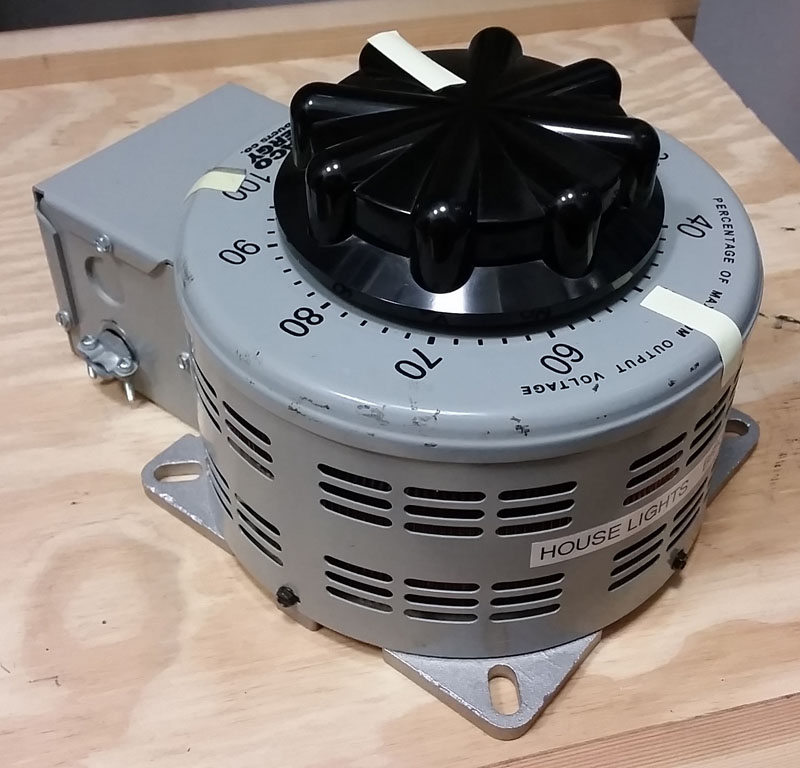 For years, many patrons and members have commented to me on the lack of adequate lighting over the seating areas in our theater. Our former “House Lights” were initially installed and later expanded by volunteers and were comprised of what were essentially exterior flood light fixtures controlled by an undersized wall switch dimmer. That wall switch dimmer was eventually replaced, for safety reasons, with a large autotransformer (photo right). While these fixtures were a good start at seating light at the time they were installed, they were not quite bright enough in many areas which created tripping hazards in our unique arena. The fixtures had also aged significantly creating a few safety hazards (e.g., some fixtures were broken and dangling from their wires).
For years, many patrons and members have commented to me on the lack of adequate lighting over the seating areas in our theater. Our former “House Lights” were initially installed and later expanded by volunteers and were comprised of what were essentially exterior flood light fixtures controlled by an undersized wall switch dimmer. That wall switch dimmer was eventually replaced, for safety reasons, with a large autotransformer (photo right). While these fixtures were a good start at seating light at the time they were installed, they were not quite bright enough in many areas which created tripping hazards in our unique arena. The fixtures had also aged significantly creating a few safety hazards (e.g., some fixtures were broken and dangling from their wires).
I began casually working with Andy Serb about two years ago in search of potential options to replace the lights; our existing lights were clearly not going to last forever. After considering many fixture options, we had tentatively settled on a plan to replace the lights with similar units that were more modern, but at the same time we would increase the quantity and then install an appropriately sized dimmer pack that would control them via our lighting console. It didn’t take long to realize that this was not the optimal solution because it required a lot of new wiring to be installed, and really didn’t add any significant capability or heat and energy savings since they still relied on conventional incandescent lamps.
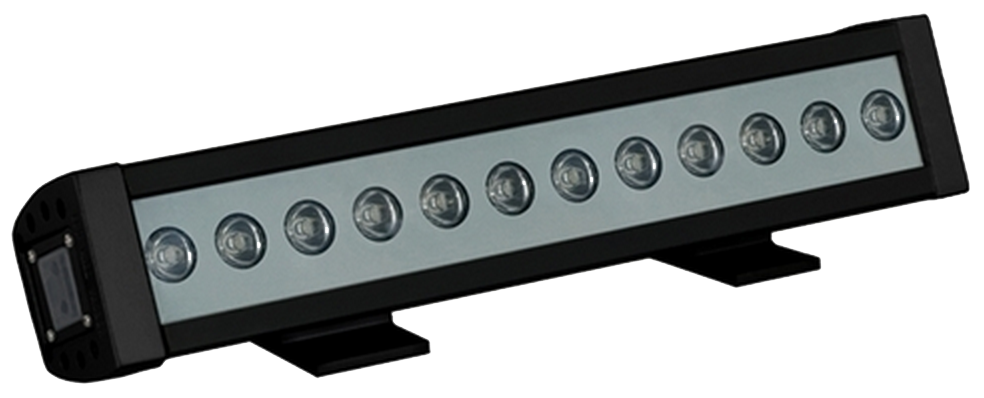 Frank Florentine became involved with the research last year and we continued to look at what other options might be available. After taking a look at quite a number of other fixtures, we had now settled on 48” RGB (Red/Green/Blue) architectural LED strip lights (photo left of shorter model). We tried out a demo model and decided that these would work well in our space, so we went to the Board and requested a budget to proceed. Four units were subsequently ordered to conduct a real in-house demonstration as well as to help us determine how many we would really need for our space. These four units, beyond being used for demo and planning purposes, actually ended up being used on stage in our productions of Annie, Coyote on a Fence, and Bits and Pieces (the 2014 Summer One-Act Festival).
Frank Florentine became involved with the research last year and we continued to look at what other options might be available. After taking a look at quite a number of other fixtures, we had now settled on 48” RGB (Red/Green/Blue) architectural LED strip lights (photo left of shorter model). We tried out a demo model and decided that these would work well in our space, so we went to the Board and requested a budget to proceed. Four units were subsequently ordered to conduct a real in-house demonstration as well as to help us determine how many we would really need for our space. These four units, beyond being used for demo and planning purposes, actually ended up being used on stage in our productions of Annie, Coyote on a Fence, and Bits and Pieces (the 2014 Summer One-Act Festival).
When the initial installation planning got underway, the question of how to mount the fixtures came to light (pun intended - I’m here all week, folks). It became clear that mounting the new lights directly to the overhead ceiling beams was not the ideal option because it left no flexibility in terms of shifting the lights around if needed, and it meant a lot of drilling into the building structure. A few of us jokingly talked about how nice a new light grid would be that covered the entire ceiling, allowing for mounting the new House Lights to strut channel, but that originally seemed like a very far-fetched idea.
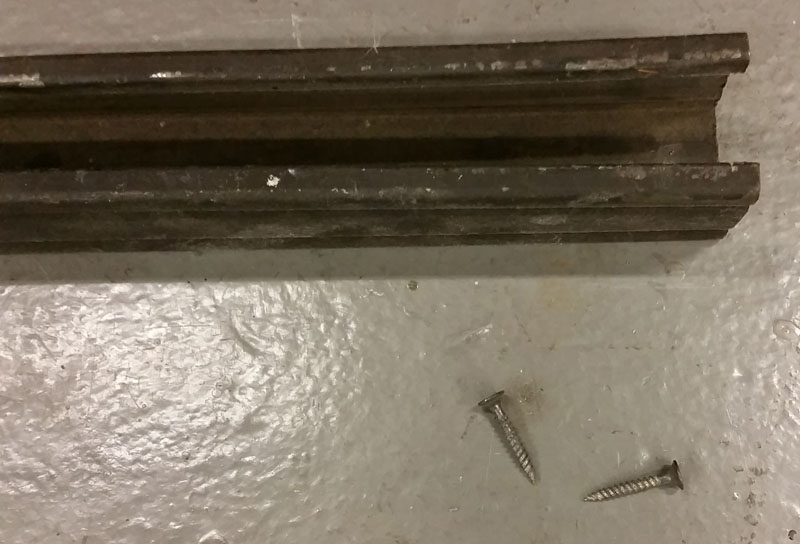 After some additional consideration, we realized that it might be in the best interest of the organization to tackle both the House Lights and a new lighting grid together. The more it was discussed, the more we realized that the existing grid was inconsistent, and was not securely installed in many areas, resulting in loose strut channel that was not suitable for hanging lights. We even found a few pieces of the grid that were not only loose, but only held up by a couple (count ‘em: 2) drywall screws (photo right)! The grid would need to be replaced sooner or later, so after a detailed inspection of the condition of the current grid, it became obvious that now was the right answer from a safety standpoint, as well as a functionality standpoint. The Board agreed with our assessment and gave us the green light to proceed.
After some additional consideration, we realized that it might be in the best interest of the organization to tackle both the House Lights and a new lighting grid together. The more it was discussed, the more we realized that the existing grid was inconsistent, and was not securely installed in many areas, resulting in loose strut channel that was not suitable for hanging lights. We even found a few pieces of the grid that were not only loose, but only held up by a couple (count ‘em: 2) drywall screws (photo right)! The grid would need to be replaced sooner or later, so after a detailed inspection of the condition of the current grid, it became obvious that now was the right answer from a safety standpoint, as well as a functionality standpoint. The Board agreed with our assessment and gave us the green light to proceed.
Detailed planning for the light grid renovation began late this past spring. Frank created CAD drawings and request for quotation letters were prepared and sent to potential contractors. We also met with a structural engineer to have the plans reviewed and endorsed. Due to the tight summer schedule this year, any construction that was to be accomplished had to be completed after the One Act Festival and before Rocket Man moved into the theater three weeks later. We weren’t sure that it could be done, and we anxiously awaited feedback from the contractors on our proposal. On the submission due date, we received responses from all three contractors. The following week, the Board of Directors met to review the proposals and downselected to Parlights, Inc. from Frederick, MD based on cost, previous experience doing similar work, and the ability to meet the demanding schedule.
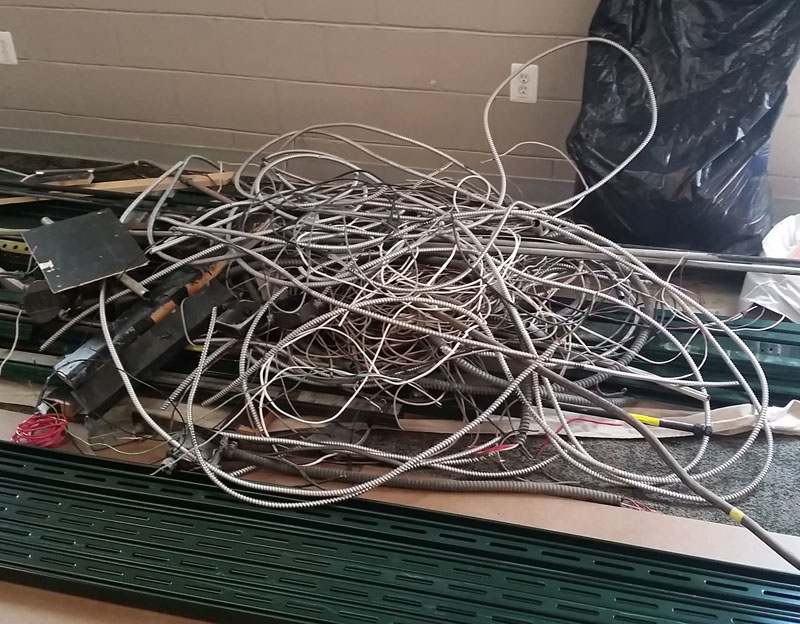 Contracts were signed, deposits were made, and work began on July 28 with demolition of the existing lighting grid and House Lights! Jon was our on-site foreman and was assisted by Mike, Flash, and Parlights’ owner Cary over the 3 week grid renovation period. Demolition went quickly and only took a day or two. All of the old strut was removed from the ceiling, as well as all of the old House Lights, conduit, backstage blues, and a lot of other unnecessary wiring, conduit, hooks, cord, and other “junk” that was in the ceiling from shows past (photo left). Immediately prior to the start of demolition, Dave Carter, his daughter Sophia, Shirley Panek, and I spent the better part of four hours removing several old deteriorated speakers that had been installed years ago in the ceiling between the wooden beams. These had been installed with tar (of all things) and 3-inch nails, which is why it took so long to remove them! The view of a completely cleared out ceiling was amazing. Following the demolition, the lobby was quite full of debris!
Contracts were signed, deposits were made, and work began on July 28 with demolition of the existing lighting grid and House Lights! Jon was our on-site foreman and was assisted by Mike, Flash, and Parlights’ owner Cary over the 3 week grid renovation period. Demolition went quickly and only took a day or two. All of the old strut was removed from the ceiling, as well as all of the old House Lights, conduit, backstage blues, and a lot of other unnecessary wiring, conduit, hooks, cord, and other “junk” that was in the ceiling from shows past (photo left). Immediately prior to the start of demolition, Dave Carter, his daughter Sophia, Shirley Panek, and I spent the better part of four hours removing several old deteriorated speakers that had been installed years ago in the ceiling between the wooden beams. These had been installed with tar (of all things) and 3-inch nails, which is why it took so long to remove them! The view of a completely cleared out ceiling was amazing. Following the demolition, the lobby was quite full of debris!
The Parlights crew began hanging new strut mid-way through the first week. We requested that they start with installing the strut over the stage area, and finish over the audience areas and alleys. In case construction fell behind, we’d be able to hang lights for Rocket Man while they finished the seating areas, allowing us to still open our season on time. As it turned out, I was concerned for nothing, because Parlights finished the work two days ahead of schedule. Better to have had a contingency plan in place, though! The Parlights crew was great fun to work with and maintained incredible attention to detail. I remember watching Flash climb a ladder to tap a piece of strut with a hammer because it was ⅛” off from where he wanted it. Jon and Mike were great about keeping me informed as work progressed and questions came up, allowing me to head off concerns before they became real problems.
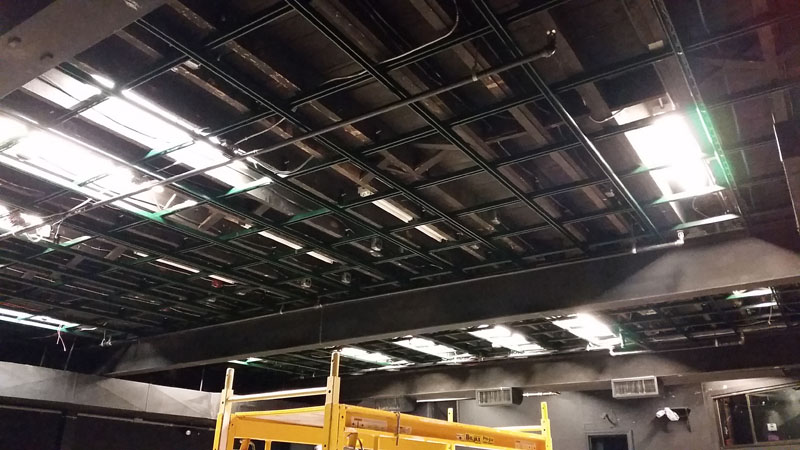 Once the light grid construction was complete (photo below), we still had a bit of work ahead of us in-house: installation of the new House Lights. The fixtures arrived roughly a week after the grid was complete. It took two trips from Maurice Electrical to get all the lights and cables to the theater! Frank and I got everything unpacked and organized, and over the course of two days and with the help of quite a few volunteers, we were able to hang all of the new House Lights, focus them, and cable them. These lights bolted directly to the new light grid, just as any other lighting instrument would, making the install very easy to delegate among our volunteers. Custom designed louvers for the new lights arrived shortly before opening night of Rocket Man and Frank installed these over the course of an afternoon. The louvers reduce glare from the lights by focusing the light downward and controlling spill, similar to a barn door on a stage instrument.
Once the light grid construction was complete (photo below), we still had a bit of work ahead of us in-house: installation of the new House Lights. The fixtures arrived roughly a week after the grid was complete. It took two trips from Maurice Electrical to get all the lights and cables to the theater! Frank and I got everything unpacked and organized, and over the course of two days and with the help of quite a few volunteers, we were able to hang all of the new House Lights, focus them, and cable them. These lights bolted directly to the new light grid, just as any other lighting instrument would, making the install very easy to delegate among our volunteers. Custom designed louvers for the new lights arrived shortly before opening night of Rocket Man and Frank installed these over the course of an afternoon. The louvers reduce glare from the lights by focusing the light downward and controlling spill, similar to a barn door on a stage instrument.
At present, we’re still in the process of working through adding a few additional House Lights to brighten some darker areas. We expect the additional fixtures and louvers to arrive near the end of the calendar year as they’re being custom manufactured for us. Other than a few dark areas yet, everything is set and worked well during Rocket Man, and was a dramatic improvement over the previous light grid and House Light system. The new House Lights are now controlled directly from our lighting console, simplifying operation for our techs and allowing full automation of all lighting in the theater space. Being RGB LEDs, they also allow us to light the seating areas in any color desired.

In addition to the light grid proposal, we had also listed an add-alternate on our request for quotation. This option requested bidders provide recommendations for LED theatrical strip lights. We figured as long as we were doing this work, we might as well find out what the cost would be for LED strips that have long been joked about among our lighting designers. Parlights recommended Phillips Showline SL BAR 660s (photo above) to replace our existing Altman R40 15-lamp traditional strip lights. The LED strips, as with all LED instruments, add incredible flexibility to what we can do with color on stage, and in the case of strip lights they eliminate the need to re-gel 90 lamps for each show. We decided to include these instruments in the contract for the grid and are very happy with the capability they have added to our lighting rig!
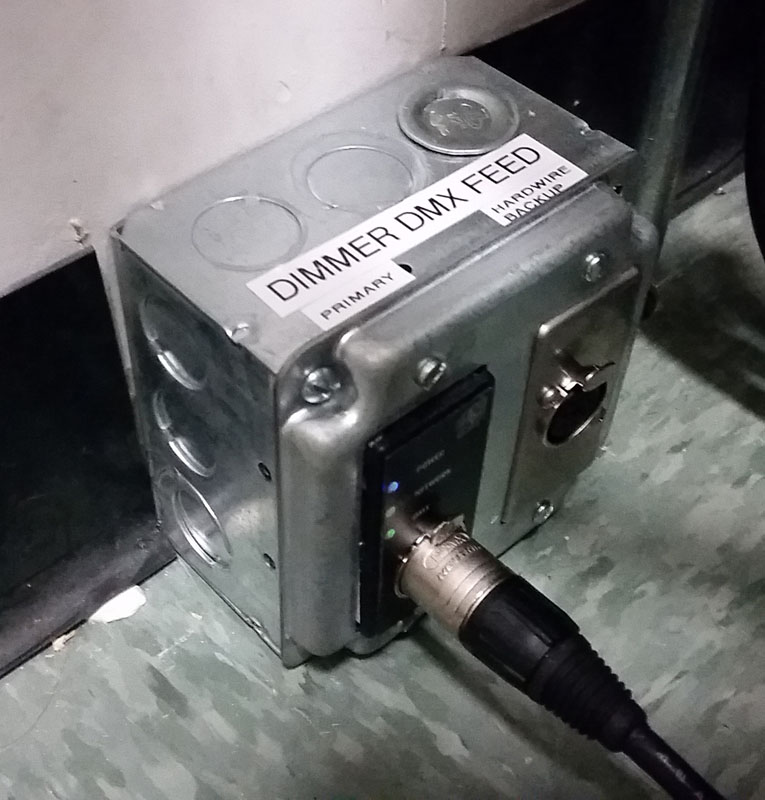 Since we’ve recently been transitioning to more LED lighting, the cherry on the cake this summer was our upgrade to Ethernet-distributed DMX. For those of you non-technical readers, DMX is a standard for digital communication networks that are commonly used to control stage lighting and effects [Wikipedia]. In other words, DMX is the “signal” we use to control all of the lighting on our stage.
Since we’ve recently been transitioning to more LED lighting, the cherry on the cake this summer was our upgrade to Ethernet-distributed DMX. For those of you non-technical readers, DMX is a standard for digital communication networks that are commonly used to control stage lighting and effects [Wikipedia]. In other words, DMX is the “signal” we use to control all of the lighting on our stage. 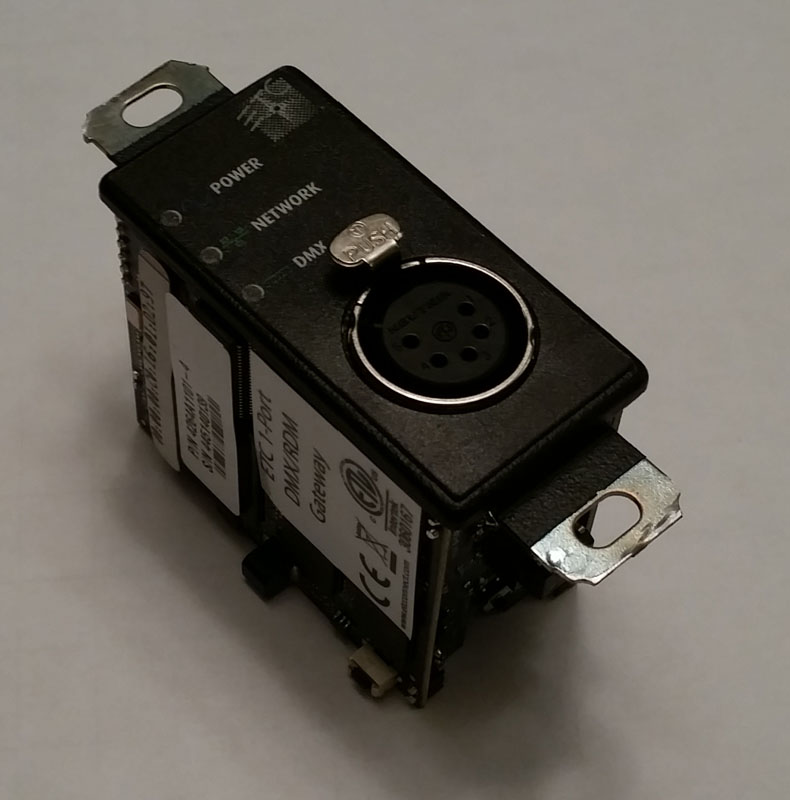 Before LED lighting, we simply had a DMX cable that was strung from the lighting console across the ceiling of the Tech Booth and back to the dimmer packs that controlled our lights. With LED lighting, each LED instrument needs a DMX connection to tell it what to do (i.e., intensity, color, position, zoom, etc.). LED instruments do not connect to traditional dimmers for control; the control is built into the instrument. To get control signal to our LEDs previously meant running a bunch of extra cables out of the Booth to the LED instruments which is not ideal.
Before LED lighting, we simply had a DMX cable that was strung from the lighting console across the ceiling of the Tech Booth and back to the dimmer packs that controlled our lights. With LED lighting, each LED instrument needs a DMX connection to tell it what to do (i.e., intensity, color, position, zoom, etc.). LED instruments do not connect to traditional dimmers for control; the control is built into the instrument. To get control signal to our LEDs previously meant running a bunch of extra cables out of the Booth to the LED instruments which is not ideal.
Today, one of the more efficient and manageable ways to handle DMX distribution is via Ethernet (i.e., via our computer network, photo below). Many professional venues use Ethernet-distributed DMX both for simplicity of installation as well as the flexibility it adds to your lighting rig. You can have many DMX “ports” (AKA Ethernet to DMX Gateways - photo above left and right) available in your lighting grid all connected to your computer network. To hook up your LED lighting instruments, you just have to run a cable to the closest DMX Gateway rather than the whole way back to the lighting console. We’ve installed several DMX Gateways in our ceiling, as well as one dedicated for the dimmer packs and another dedicated for our House Lights. This simplifies setting up LED instruments for each show and again, increases our flexibility.
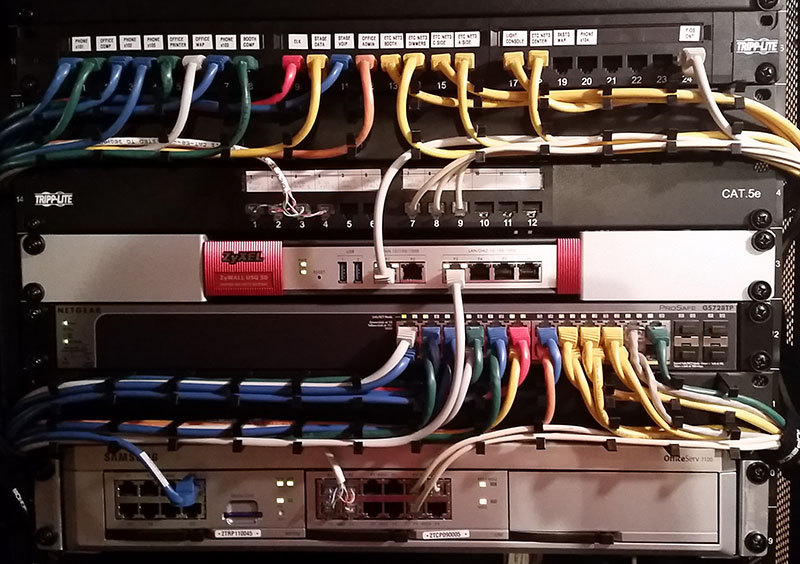 We’ve made quite a few changes this summer that will dramatically enhance what we can do with lighting on our stage. We’ve reinvested in ourselves to continue to improve the quality of our productions, as well as the technology with which our designers are able to work. In addition to contracted professional labor, we used extensive volunteer help from many of our members to accomplish everything in a short amount of time. We’re very excited about the increased capability and safety of our new lighting grid and House Lights, as well as the flexibility added by our new LED strip lights and DMX Gateways. I hope the improvements and efforts of our volunteers are evident to everyone, and I hope that if you have an interest in learning about how we do what we do behind the scenes you let us know! If you have any comments or questions about the renovation efforts, feel free to leave them below.
We’ve made quite a few changes this summer that will dramatically enhance what we can do with lighting on our stage. We’ve reinvested in ourselves to continue to improve the quality of our productions, as well as the technology with which our designers are able to work. In addition to contracted professional labor, we used extensive volunteer help from many of our members to accomplish everything in a short amount of time. We’re very excited about the increased capability and safety of our new lighting grid and House Lights, as well as the flexibility added by our new LED strip lights and DMX Gateways. I hope the improvements and efforts of our volunteers are evident to everyone, and I hope that if you have an interest in learning about how we do what we do behind the scenes you let us know! If you have any comments or questions about the renovation efforts, feel free to leave them below.
If you’re interested in learning about lighting, be sure to check out the Introduction to Stage Lighting workshop being given at our theater by Parlights on November 1st. Also, don’t forget to get tickets to our upcoming production of A Few Good Men which makes use of our new LED stage strips!
For The Love Of It,
~W
Don't miss out! Sign up for our email list by clicking here!
To contact The Colonial Players, please refer to the email directory on our Contact Us page or email info@thecolonialplayers.org.
For questions about tickets and subscriptions, email boxoffice@thecolonialplayers.org.
For website comments, questions, suggestions, as well as copyright and usage information, please contact webmaster@thecolonialplayers.org.
Copyright 2025 • The Colonial Players, Inc. • 108 East Street • Annapolis, MD 21401 • Phone: 410-268-7373
